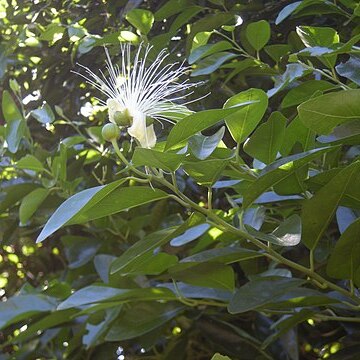Shrub or tree, 8–10 m high, hairy to almost glabrous. Spines acicular, straight, spreading, 5–11 mm long, mostly absent in adult branches. Leaves elliptic to ovate, acute to obtuse, sometimes mucronate, 5–15 cm long, 1.5–6 cm wide, glabrous above, hairy below; base acute, midrib shallowly sunken; veins 6–10 pairs; petiole 6–19 mm long. Inflorescence solitary, paired, or rarely 3–7 in axils; pedicels 3–6 cm long. Sepals 8–19 mm long, glabrous, the outer pair sometimes minutely hairy. Petals 13–31 mm long, 10–15 mm wide, fimbriate, sometimes with a claw to 7 mm long; base with woolly hairs. Stamens 95–100. Gynophore 2–5 cm long, glabrous; ovary ovoid, c. 4 mm long, glabrous; placentas 3 or 4. Fruit globose, sometimes umbonate, 2–3.3 cm diam. Seeds several; axis through attachment c. 7 mm long.
More
An evergreen scrambling shrub. It can be 2-5 m tall. It can grow to 8 m tall. It has a thick woody trunk at the base. The stems have sharp prickles. The leaves are oval and dark green. They are 6-15 cm long by 2-6 cm wide. Flowers are white or cream. They are 3-6 cm across. The flower buds are covered with woolly hairs., The fruit is a berry. It is round and yellow and 5 cm across. The fruit is edible.


